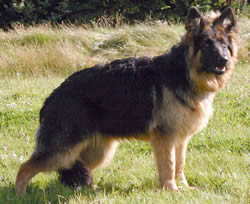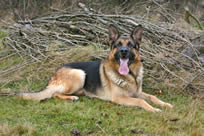German Shepherd
(Alsatian)
|
Photo with thanksJanet Smith, Mystical's Shepherds, www.mysticalkennels.com |
See more German Shepherd Pictures, Pics 1 Pics 2 and Puppy Pics
German Shepherd
Breeders & Puppies For Sale If your
a German Shepherd breeder and have German Shepherd puppies for sale, send us your details for free and we will add to our German Shepherd Breeders page.
German Shepherd
Rescue Center Visit the German Shepherd rescue centers if your looking to rescue a German Shepherd, as well as learn more about the breed or just support the rescue centers for there hard work.
Group Pastoral Dogs (KC)
Origin /
History The German Shepherd Dog was developed in Germany during the late 19th century and early 20th century because people wanted to have the ultimate sheepdog. Captain Max von Stephanitz was the one who created this breed by cross-breeding short-haired, wire-haired, and long-haired shepherd dogs from Thurginia, Bavaria, and Wurtemberg. In 1899, he had his first German Shepherd, named Horand von Grafrath, registered as a breed. This dog became the genetic basis for today's German Shepherds.
Breeders of the German Shepherd strived to make an intelligent, brave dog that can run fast and is capable of herding sheep. These breeders created a powerful, agile dog that immediately proved itself useful for guarding and police work. During the first World War, they changed the dog's name to 'Alsatian' in order to protect the breed. In some countries, this name was retained, while in others, it lasted for only a short time. Today, German Shepherds are known for their abilities such as guarding, guiding, and drug-sniffing. Aside from that, they also make good police dogs and can participate in search-and-rescue missions. They can also be good family companions.
Appearance The German Shepherd comes in three varieties: long-haired, long rough-coated, and rough-coated. These dogs are strong, large, and well-proportioned. Their noses are usually black, although there are some that have liver or blue-colored noses. These dogs' heads must be proportional to their body. They have almond-shaped eyes which are dark and sport intelligent, lively expressions. Their shoulders and front legs are muscular, and they have sturdy and thick thighs. Their feet are round and their soles are very hard.
Colours These dogs have coats that are usually tan with black masks and black-colored backs. However, these dogs can also come in other colors such as solid black, brown, gray, and yellow. They may also be tricolor (white, black, and red or brown), or sable (black and silver, red, or tan). These dogs can also have black markings.
Temperament Although these dogs are fearless, they are not aggressive or hostile. They are loyal, brave, protective, and obedient. They make great companions, and they are also good watchdogs. They can adapt well to various lifestyles. These dogs are wary of strangers, and they will alert their family when unfamiliar characters get to near their property. They also do not prefer being with other canines. Despite that, though, these dogs can get along well with children as well as other animals just as long as they have been properly socialized.
Height and
Weight 56 - 66 cm in height and 34-43 Kg in weight. Males are larger than females and at the top end of the size ranges.
Common Health
Problems Since this is a popular breed, these dogs tend to be susceptible to various health problems such as elbow dysplasia, hip dysplasia, digestive problems, blood disorders, chronic eczema, epilepsy, dwarfism, flea allergies, and keratitis.
Living Conditions Although these dogs will be relatively inactive indoors, they can be kept inside apartments if they are given sufficient exercise. It would be best, though, if these dogs are provided with large yards where they can play and do some activities.
Exercise
Requirements These dogs should be given activities to do, as they are happiest when they are working. They should be taken out for brisk, long walks daily. They can also participate in obedience, police, or agility trials. Owners must be careful not to overexert puppies, though, as doing so may damage their joints and bones.
Training Requirements Since these dogs are eager to learn, they will respond well to training. Positive reinforcement methods will work well for this breed and harsh training should be avoided. These dogs should also undergo proper socialization while they are still young.
Life Expectancy These dogs live for around 13 years.
Grooming Dogs of this breed must be combed and brushed on a daily basis. Bathing should be done only one or two times in a year because frequent bathing will strip their coats of natural oils.
Famous Examples
CompleteDogsGuide Comment
Breeders
Comments: Send us yours comments, advice for owners, potential owners etc.
Janet Smith, Mystical's Shepherds says : "As an owner this is a great breed, I have kids and they are so great with them. They are also guarding your house and let you know whenever someone or something is around. If not careful they will try to herd you for that is in their blood. I have had puppies to getting a 2 year old adult and either one is just fine and adjusts quickly to its new home. So if you would like to rescue one then I would suggest doing so, for an adult that is already trained would make a great first time german shephed owner."
Owners Comments: Send us any of your comments. Thanks in advance.
Janet Smith, Mystical's Shepherds says : As a breeder they are not for everyone, they need someone that can handle such a strong breed and if not trained they can be a bit much for a first time owner. They can take over if you are not careful. All puppies are cute but I would only suggest getting one from a good breeder. One that does some sort of tests, gives a guarantee and willing to help you no matter what the age of your dog is. Letting the breeder pick the best pup to fit your family is a plus for a breeder knows how each pup is, some maybe high strung so should be in a working home, to where others are more laid back and would make the perfect family companion.
More German Shepherd Information: Check out our German Shepherd Clubs and links to more informative websites dedicated to the breed.
Submit your German Shepherd pictures Send us any pics of your German Shepherd, let us know there name and age and any other details. We'll add to this page. Contact us
| German Shepherd |
Eliza 4-5 months old |
|
|
UKC CH Gretchen Julika Little Star, TT CERF
Standard coat, West German/American Bloodlines
3 1/2 years old, Black/Red
Mystical's Shepherds
|
Mystical's Heavens Zhaan D'Argo/Newton's Warrior of Troy
Sable color, Standard Coat
American/German bloodlines
|
Photos with thanks to
Janet Smith, Mystical's Shepherds,
www.mysticalkennels.com |
| Lexi is a long coated bitch from top German bloodlines |
Jack is a home bred, short coated black and gold dog |
 Lexis's both parents are championship show winners and are hip scored. She is very laid back and friendly |
 Jack's Both parents are qualified in working trials and obedience. He is KC registered with an excellent pedigree. Hip score total 9. He truly is a gentle giant and continues to produce top quality pups. |
Photos with thanks to
Sherry, www.siegerson.co.uk |
|